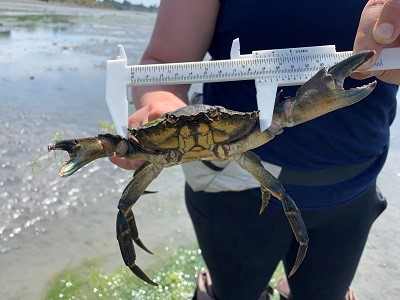European green crab
Overview
 European green crabs (Carcinus maenas) are considered one of the world’s most damaging invasive species1. They were first found in Washington inland marine shores in 20162. In other parts of the world, invasive European green crabs have reduced shellfish numbers3, 4 and damaged eelgrass beds5, 6, 7. In the Pacific Northwest, they also have the potential to compete with, and prey on, native crabs7, 8 including commercially and culturally important Dungeness crab. Unless controlled, European green crabs could cause substantial impacts to biodiversity and nearshore ecosystems3.
European green crabs (Carcinus maenas) are considered one of the world’s most damaging invasive species1. They were first found in Washington inland marine shores in 20162. In other parts of the world, invasive European green crabs have reduced shellfish numbers3, 4 and damaged eelgrass beds5, 6, 7. In the Pacific Northwest, they also have the potential to compete with, and prey on, native crabs7, 8 including commercially and culturally important Dungeness crab. Unless controlled, European green crabs could cause substantial impacts to biodiversity and nearshore ecosystems3.
After they were found in Washington in 2016, European green crabs continued to be found in a small number of isolated locations (e.g., Dungeness Spit). In 2019, Washington Sea Grant’s (Sea Grant) Crab Team and Washington Department of Fish and Wildlife (WDFW) discovered signs of a relatively large number of European green crab in Drayton Harbor. This led researchers at WDFW and Sea Grant to consider this area a new “hotspot.” Taylor Shellfish also found signs of European green crab in Samish Bay during 2019.
Since 2020, we have worked with WDFW, Sea Grant, and many other local partners to create a removal trapping program to reduce the number in Drayton Harbor. Ongoing trapping efforts by shellfish growers in Samish Bay suggested the need for a similar trapping program, which the Commission started in 2022. Based on continued captures of European green crabs, both Drayton Harbor and Samish Bay remain sites of ongoing concern.
What we're doing
To reduce the chance of European green crabs establishing a self-sustaining population, the Commission coordinates and supports trapping efforts in Drayton Harbor and Samish Bay. Commission staff also do community outreach on European green crab identification and inform local residents about the importance of European green crab monitoring and removal. This is often done with county Marine Resources Committees.
Commission staff, in collaboration with WDFW and Sea Grant, developed a strategic control trapping program to remove European green crabs from Drayton Harbor and Samish Bay. Staff work with Veterans Conservation Corps interns, Washington Conservation Corps crewmembers, and local volunteers to coordinate and carry out frequent and intensive removal trapping efforts at these two sites. Staff builds capacity for additional trapping and outreach efforts in the region through partner engagement as well.
What to do if you find one
If you find a European green crab, please report it but do not remove it. This may sound counterintuitive but is intended to protect native crabs from cases of mistaken identity. Instead, take photos to confirm your sighting, mark your location, and report your finding to WDFW. It is illegal to possess live European green crabs in Washington.
Help from community members has been key for finding European green crabs in previously unknown areas! Photo reports from the public allow WDFW and partners to follow-up on confirmed sightings. You can learn how to distinguish European green crab from similar-looking native species on the WA Sea Grant Crab Team web resources.
-
Washington Sea Grant
Washington Sea Grant information on their work on European green crab in Puget Sound.
View the Project Details »
-
Washington Dept of Fish & Wildlife
Washington Department of Fish and Wildlife's European green crab information.
View the Project Details »
-
Join our Team! NOAA WDVA Veterans Conservation Corps Fisheries Internship Program
The VCC internship provides a paid opportunity to contribute to a collaborative effort to monitor invasive European green crab and learn strategies for natural resource protection using community engagement approaches.
View the Project Details »
Additional Resources
Other Resources